What is Gyukatsu?
Gyukatsu (deep-fried beef steak cutlet) is a Western-style Japanese “yoshoku” dish consisting of beef fillet coated in a batter and panko breadcrumbs, then deep-fried. It is also known as beef katsu (ビーフカツ), bifukatsu (ビフカツ), or beef cutlet (ビーフカツレツ).
It’s often eaten with shredded cabbage, rice, miso soup and served with salt, wasabi, or katsu sauce on the side for dipping.
It is traditionally popular in the Kansai region of Japan, including Kyoto and Kobe, where the beef-eating culture is more prominent.
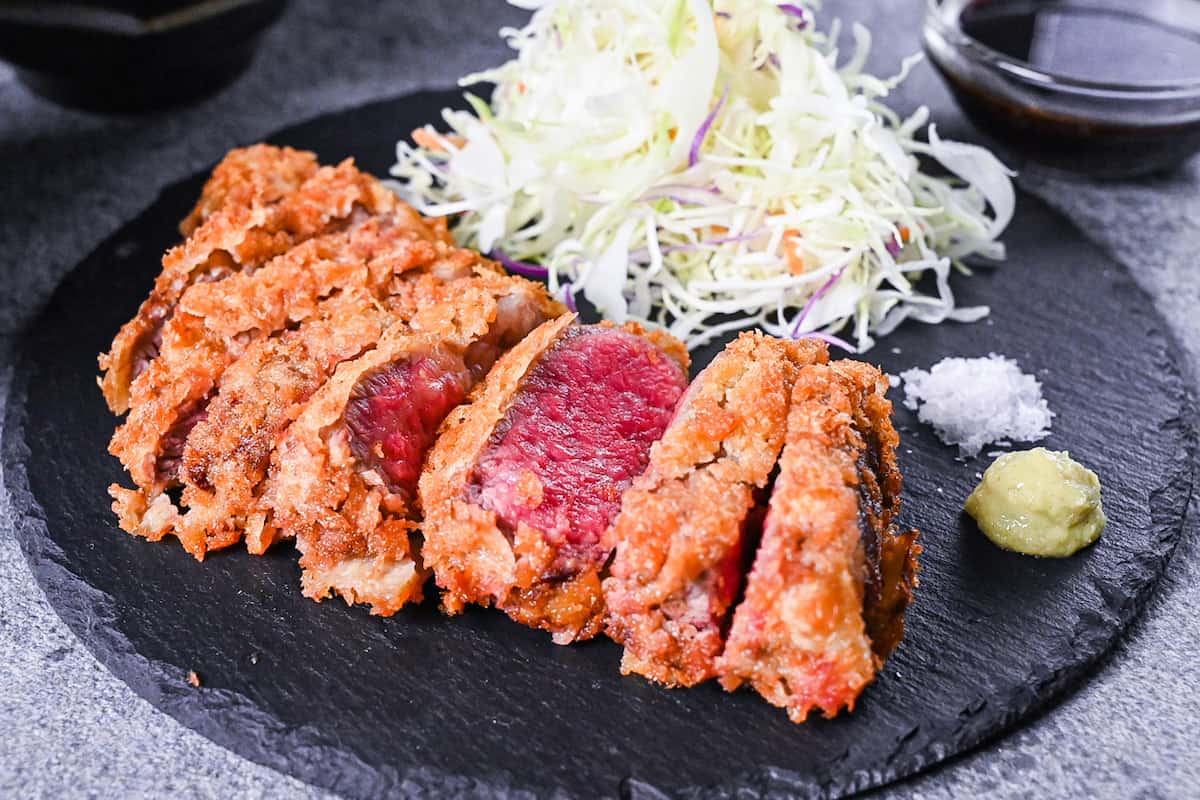
Ingredients & Substitution Ideas
- Thick Beef Steak: Opt for cuts like round, sirloin, or loin, approximately 2 cm thick.
- Herbs: Enhance the flavor with bay leaves, rosemary, and dill.
- Yellow Onion (Optional): To use the Chaliapin technique. White onions can also be used as an alternative.
- Batter Ingredients: Combine all-purpose flour, egg, milk, and panko breadcrumbs to create a smooth batter for coating.
- Cooking Oil: Select neutral oils with high smoke points, such as canola, sunflower, or peanut oil. Rice bran oil and extra virgin (white) sesame oil are also excellent choices for shallow and deep frying.
- Salt & Wasabi: Offered as optional dipping condiments, adding a spicy and savory kick to the steak.
- Sauce Ingredients: Create a rich sauce with soy sauce, red wine, mirin, and a blend of ginger & garlic paste.
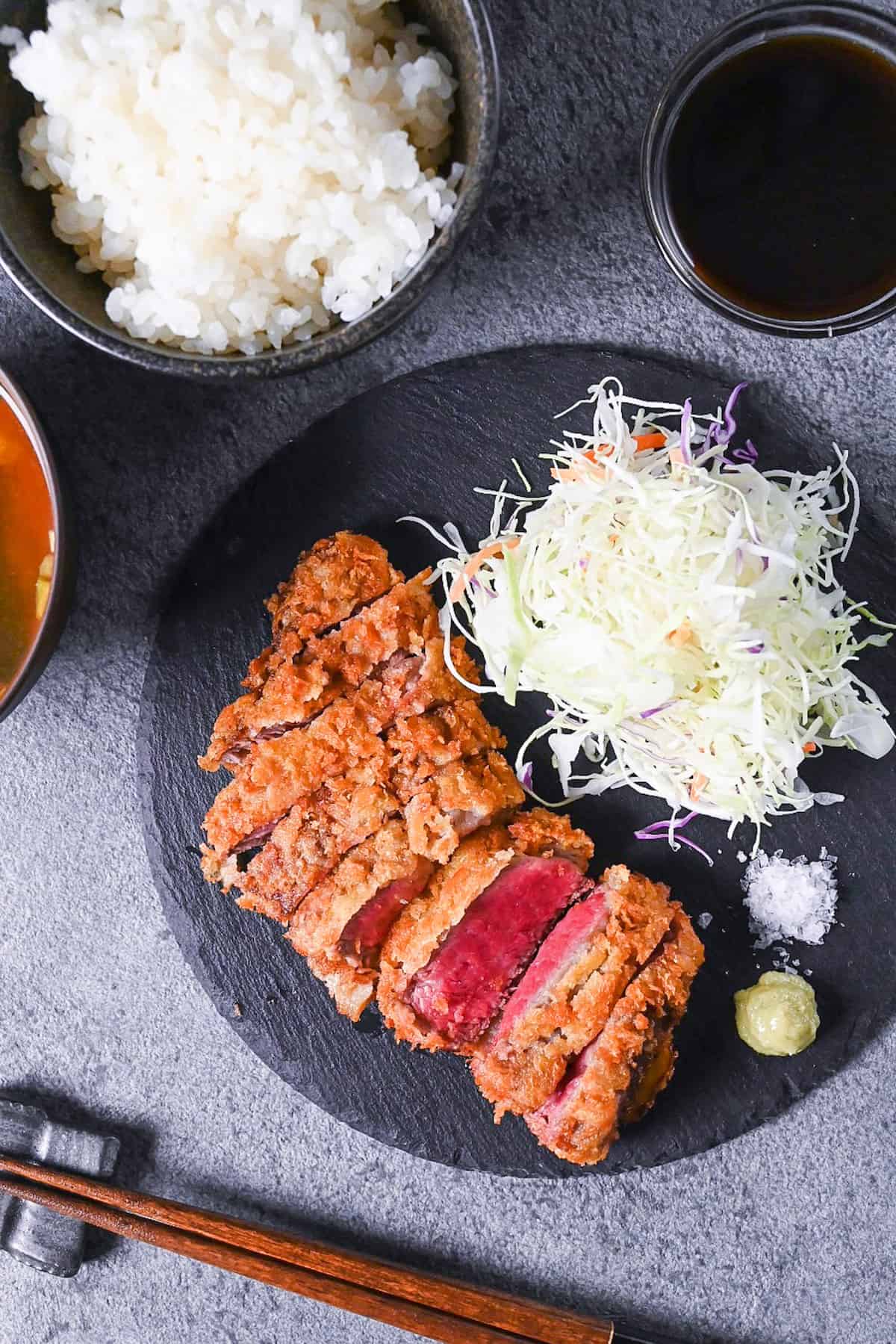
Visual Walkthrough & Tips
Here are my step-by-step instructions for how to make Gyukatsu at home. For ingredient quantities and simplified instructions, scroll down for the Printable Recipe Card below.
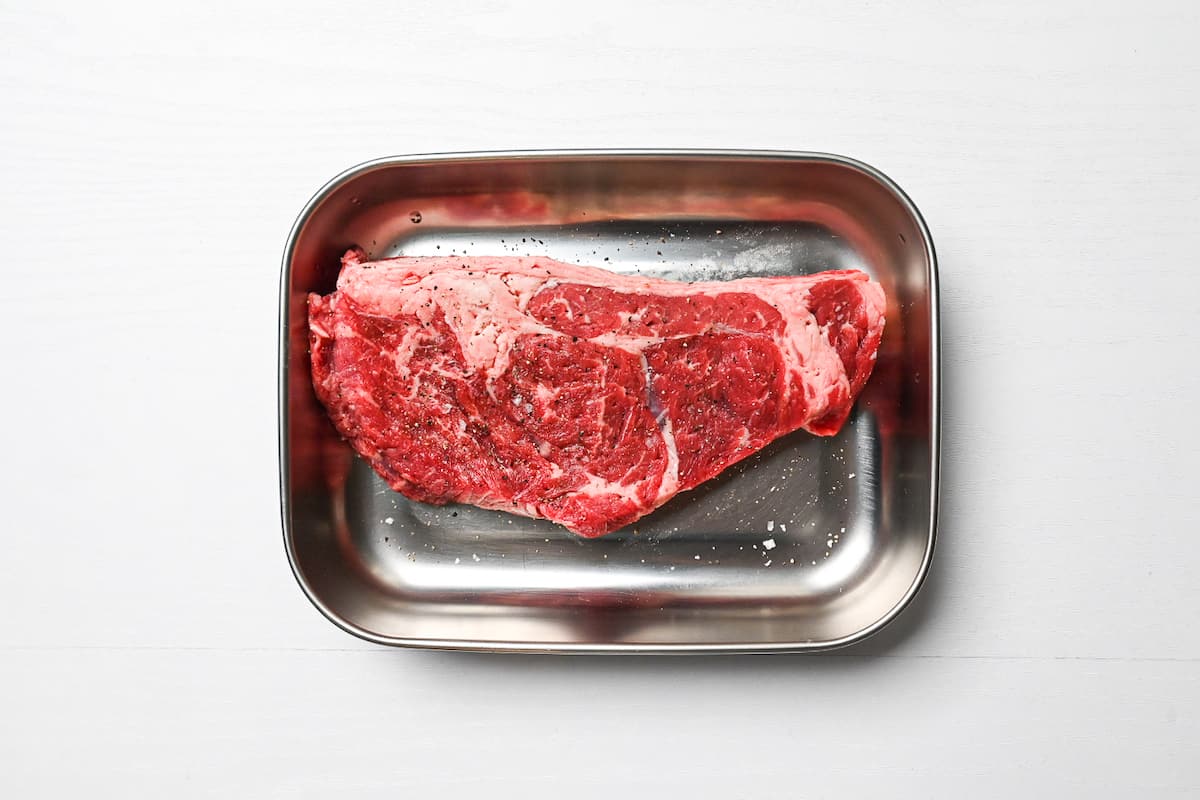
The first step when prepping your steak is to pierce both sides multiple times with a clean fork. This step helps make the meat more tender and also allows any flavors from herbs or marinades to travel deeper into the steak, making it more flavourful all the way through.
When piercing, it is important to use a clean fork to prevent transferring bacteria into the meat. This is especially important if you’re like me and prefer steak cooked rare or medium rare.
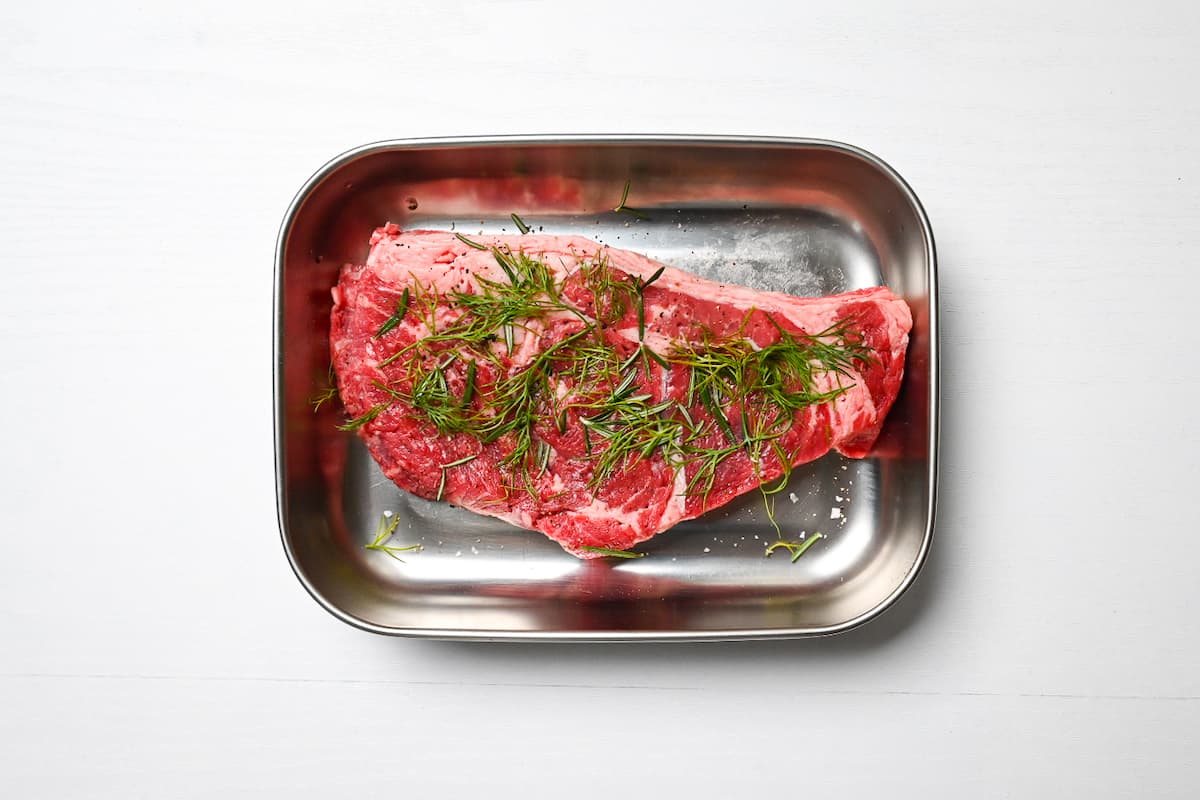
Once that’s done, pat it dry with a paper towel and add your herbs and seasonings. I sprinkle both sides with salt and pepper, then top with fresh rosemary, dill, and bay leaves. You can use your own favorite herbs for this!
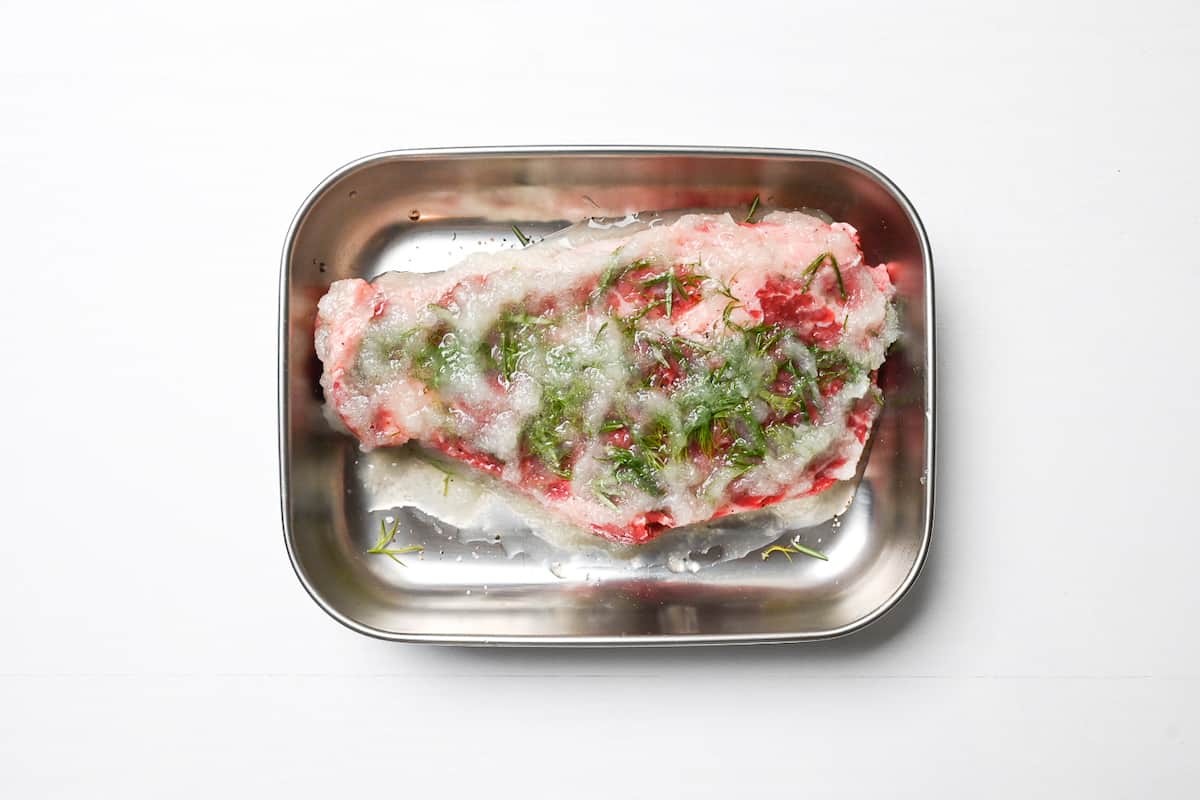
Did you know there’s a method called “enzymatic tenderization,” where the juices of certain fruits and vegetables help break down the connective tissues in meat, giving it a melt-in-the-mouth texture? Some of these ingredients include onion, pineapple, papaya, and figs.
I learned about this technique when researching for my Chaliapin steak donburi recipe. The great thing about “enzymatic tenderization” is that even if you use cheaper cuts of meat, you can still produce a beautifully tender steak, or in this case, Gyukatsu.
I grate the onion so that the texture is pulpy and easy to spread, but you can finely dice it if you prefer.
Once the steak is coated, cover it and keep it in a cool place for 30 minutes. I don’t recommend refrigerating as this slows down the enzymes. You also want the steak to be around room temperature when it’s time to cook.
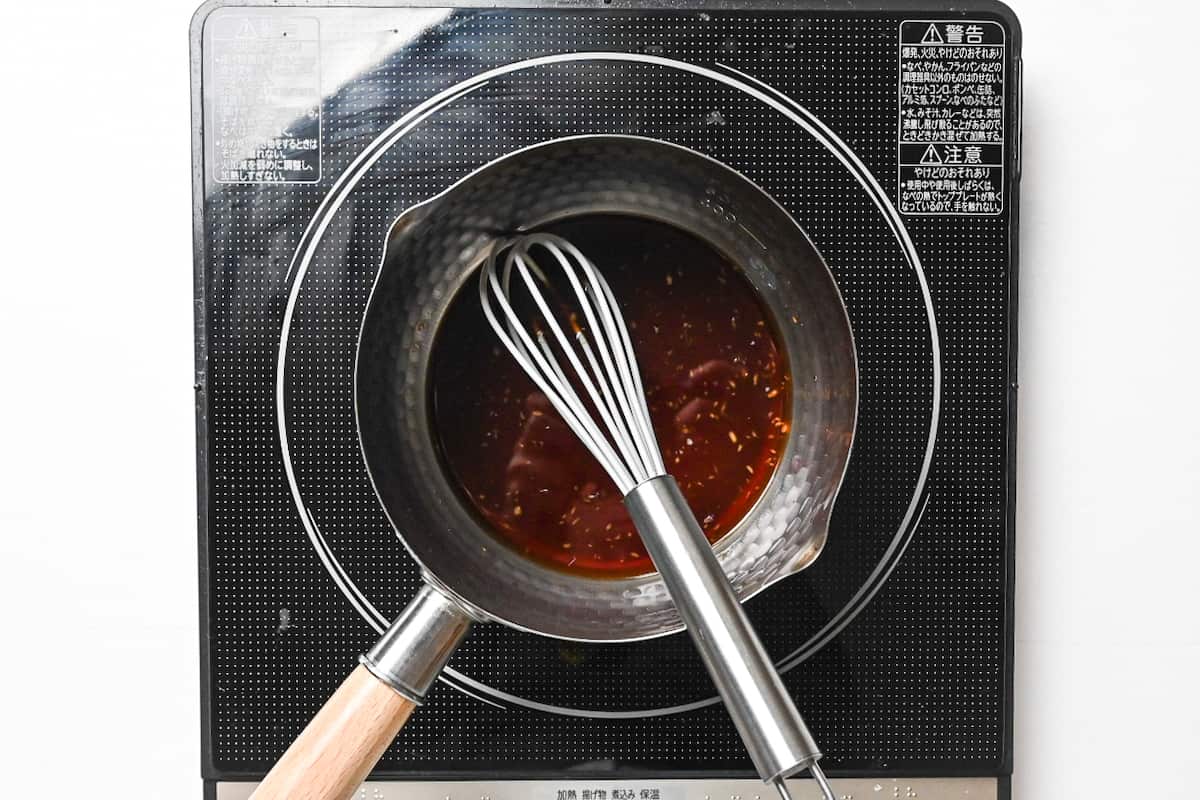
The dipping sauce is quick and easy to make. Simply add soy sauce, mirin, red wine, garlic paste, and ginger paste to a small saucepan and bring to a boil. Once boiling, lower the heat and let it bubble for 1 minute to burn off the alcohol in the mirin and red wine.
Allow it to cool before serving.
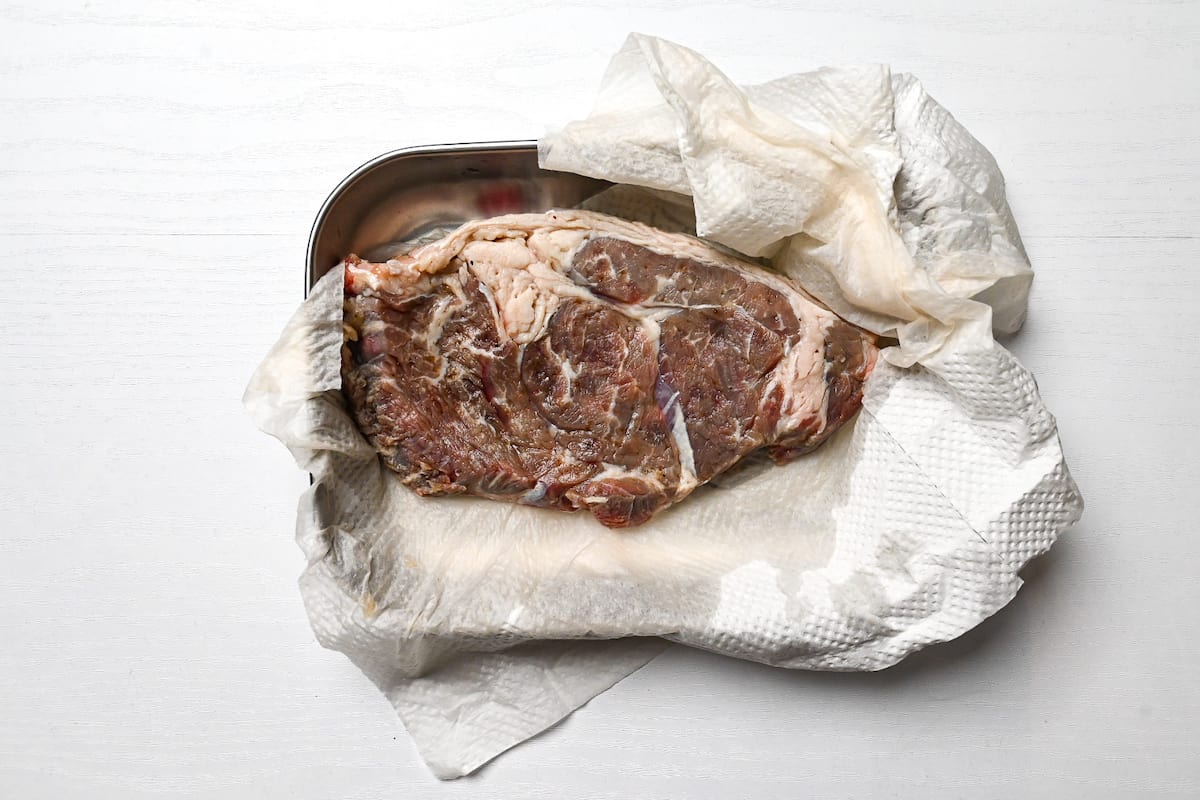
Once 30 minutes have passed, scrape the onion and herbs off of the surface of the meat and discard them. Then, wash the steak gently with cold running water and pat it dry with a paper towel. You will probably find that the meat has become discolored; this is a reaction from the enzymes in the onion and is no cause for concern.
It’s important that the surface of the meat is clean and dry to allow the panko breadcrumb coat to stick properly.
The most common way to make Japanese katsu dishes is by coating them in a thin layer of flour, whisked egg, and then a thick layer of panko breadcrumbs.
First, coat with a thin layer of plain flour.
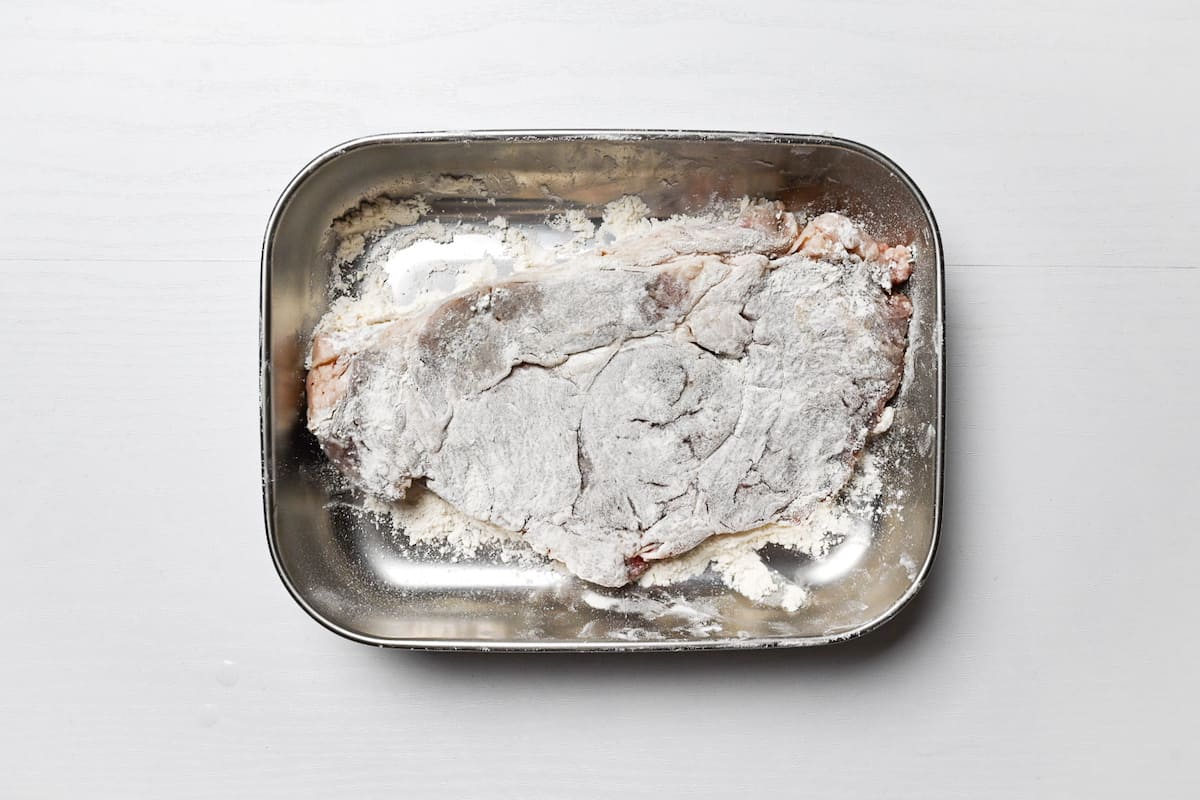
When coating the beef with flour, make sure it’s a thin layer and brush or pat off any excess. Flouring the meat helps keep the juices from the meat in and dries the surface so that the egg layer sticks better.
The reason you shouldn’t add too much is because excess flour falls off easily, it will fall off into your eggs and the batter could fall off completely at the end, a thin even layer is best.
Next, coat with an even layer of whisked egg.
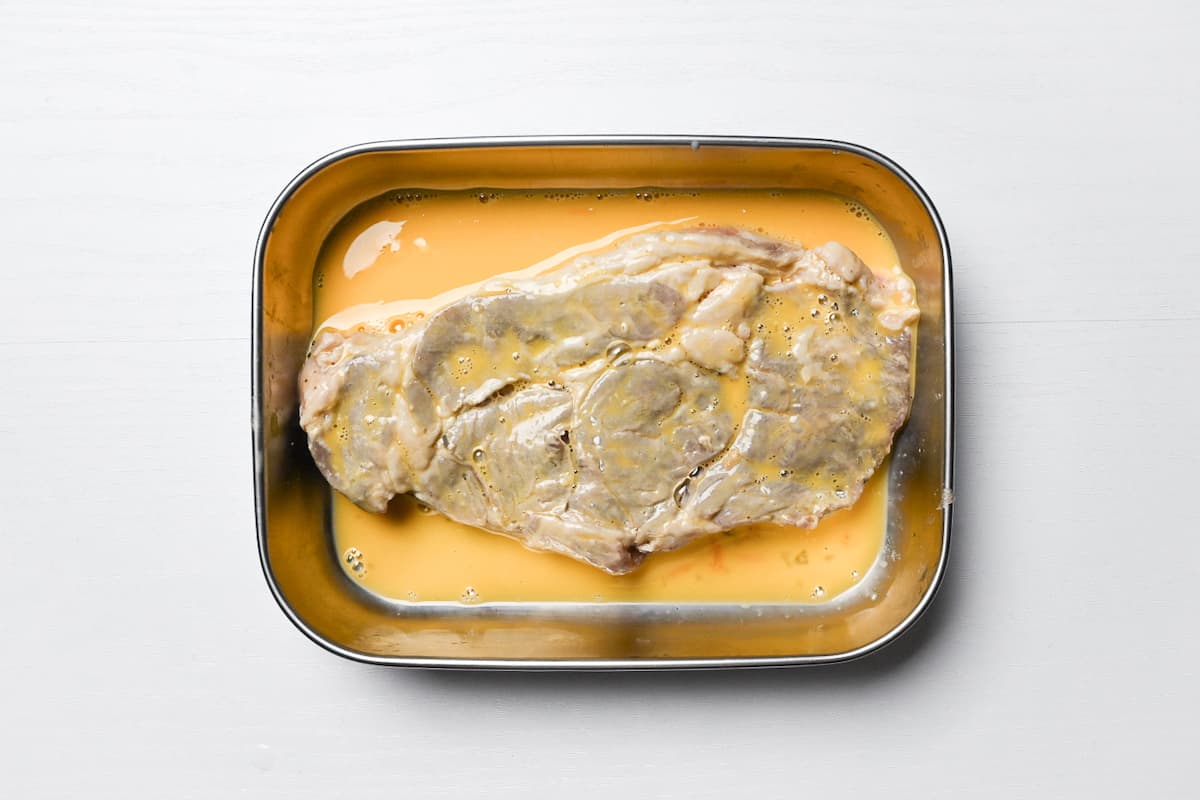
A little trick I learned from watching professional chefs make katsu, is to add a little bit of oil and milk to the eggs.
Firstly, the milk’s protein helps soften the meat, making it more tender. It also stretches the egg out further if you’re making lots of katsu (just don’t add too much!). I usually add no more than 1 tablespoon of milk for each medium-sized egg.
The other trick is adding some vegetable oil (or other mildly flavored oil). When you whisk the oil with the egg, the texture becomes smoother, creating a more even layer to stick your panko to. I add just 1 tsp of oil for each medium-sized egg.
Finally, add a generous coating of panko breadcrumbs. You can use store-bought panko, or make your own with my homemade panko breadcrumb recipe.
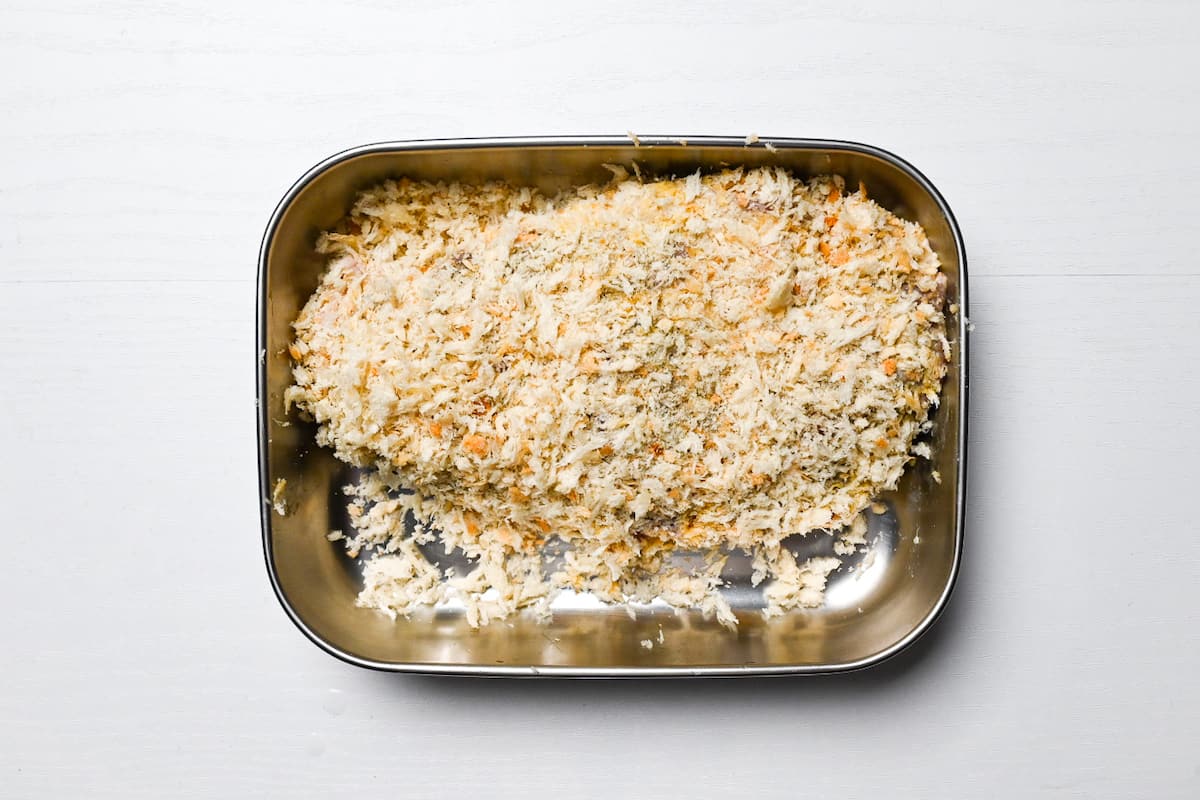
While the flour and egg layers should be thin and even, I like to be a bit more heavy-handed with the panko breadcrumbs. Ensure the cutlet is completely covered, and gently press it with your hand to secure it to the surface. Also, be sure that there aren’t any gaps!
When deep frying, you should use a mild flavored oil with a high smoke point such as vegetable oil, canola oil etc. There should be enough oil so that the katsu doesn’t touch the bottom of the pot, if it touches the bottom then the panko can become burnt.
Preheat the oil to 180°C (356°F).
Cooking beef katsu requires a higher temperature than regular katsu. I always heat my oil to 180°C (356°F). We use a high temperature so that the outside cooks quickly while the inside stays rare; essentially, it’s the opposite of how we’d cook pork and chicken, which need to be cooked thoroughly all the way through. This is also why you can’t use this pork or chicken katsu recipe. (Check out my pork tonkatsu or chicken katsu recipes for correct temperatures and cooking times.)
On the other hand, any hotter than this and the panko could burn and taste bitter; any lower the batter will take longer to crisp up, resulting in well-done beef that could become quite tough and chewy.
Cooking steak to your preferred done-ness is always a bit of trial and error, but 45 seconds on each side at 180°C is perfect for a rare gyukatsu. I highly recommend using a thermometer for gyukatsu; accuracy is important for cooking steak.
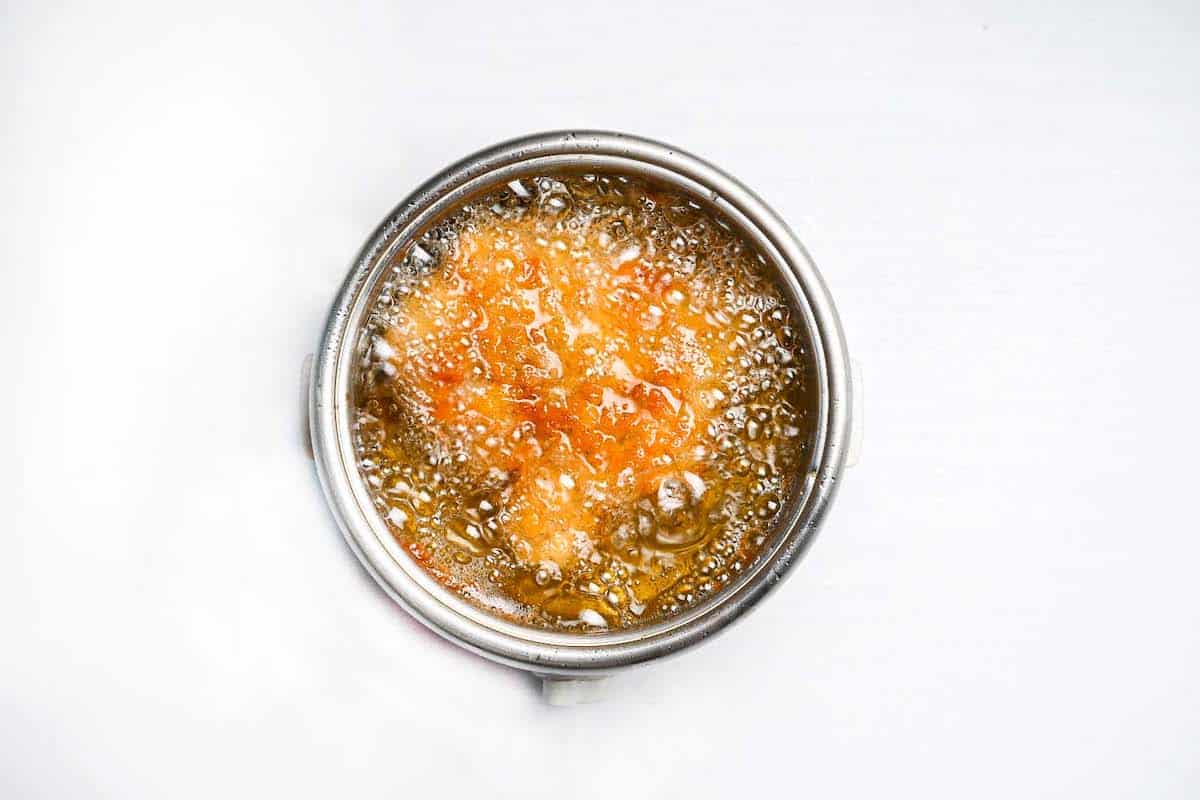
Place the gyukatsu in the oil and fry for 45 seconds on one side, then turn it over and fry for another 45 seconds on the other side. This will cook the steak to “rare” and the panko will be golden and crispy. If you want medium rare, increase the cooking time to 1 minute on each side (2 minutes in total).
The final step is placing the gyukatsu in the oil. The moment when you first place the gyukatsu in the oil is the point when it is at its most delicate, and rough handling can cause the panko to fall off straight away. It’s important to place it gently and not move, stir, or flip it too early.
Once it’s cooked, place the gyukatsu on a wire rack and allow the excess oil to drain off for a few minutes.
Japanese katsu is usually cut into strips so that it is easy to pick up with chopsticks and eat. In the case of gyukatsu, it’s also nice to be able to see the pink hue of a perfectly rare steak in every slice.
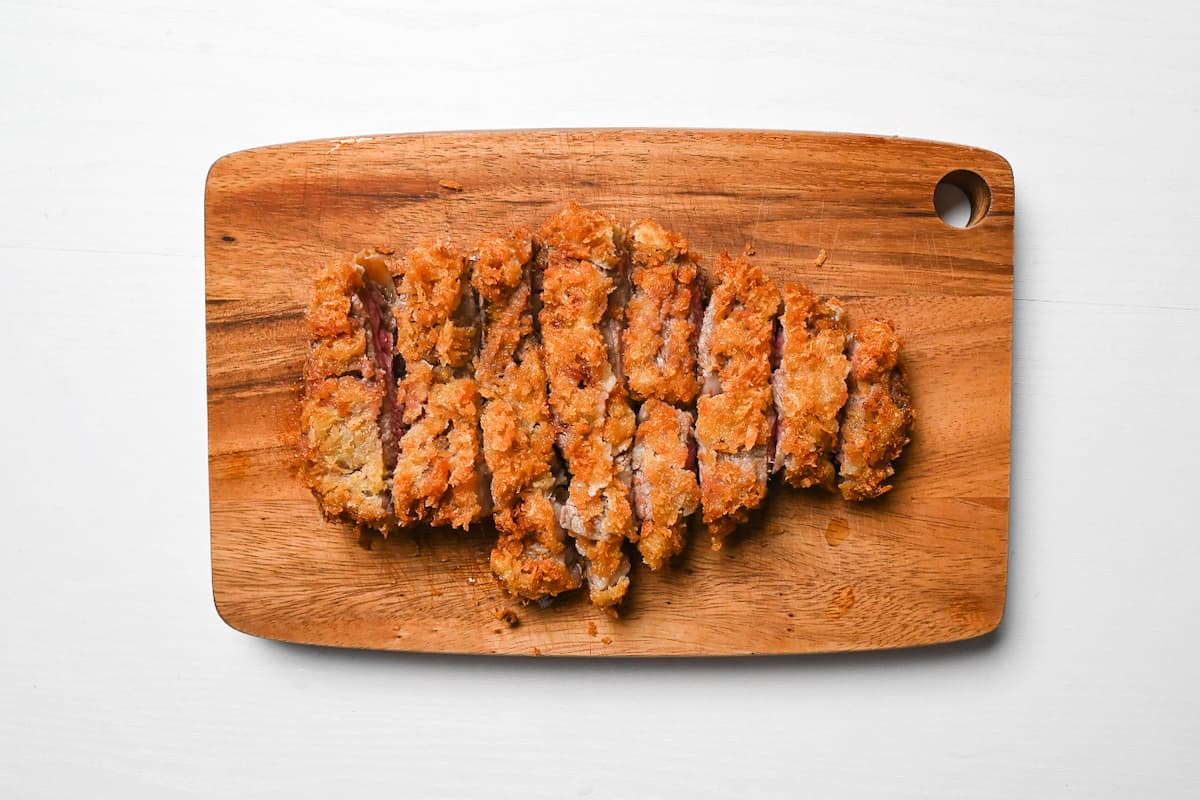
I recommend cutting into 1.5cm thick (about 1/2 inch).
Serve the perfectly cooked gyukatsu with your homemade dipping sauce (or soy sauce/salt) and enjoy!
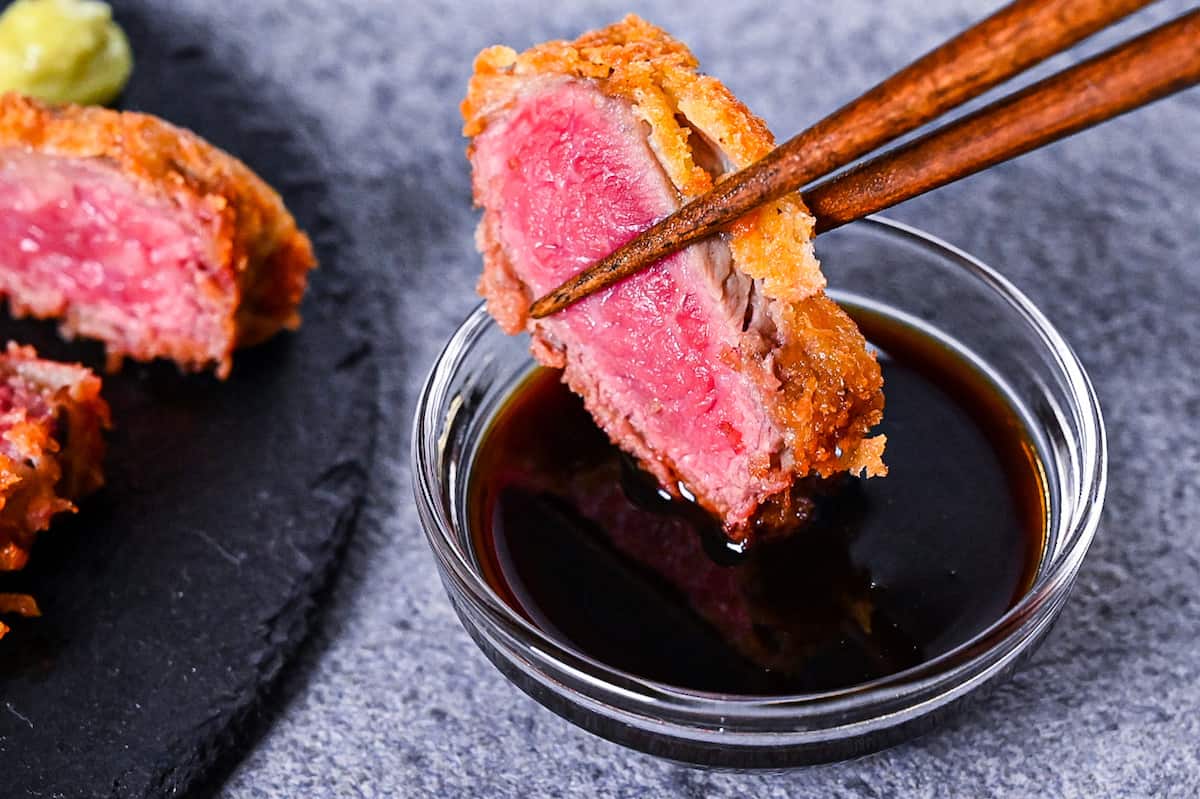
FAQ
Japanese cutlets, or katsu, are meat dishes that involve coating a piece of meat in breadcrumbs and deep-frying it. The dish was originally inspired by the French cutlet (côtelette). This applies to beef katsu, pork cutlets (tonkatsu), and chicken katsu.
There are a few theories about the origins of gyukatsu. One theory suggests that “Yosoku Kiraku” in Tokyo developed the “beef cutlet” and served deep-fried aged meat medium rare. Another theory claims that “Gyukatsu Okada” in Tokyo began using deep-fried rare steak and is credited with creating the current form of gyukatsu served with wasabi and soy sauce.
While the two theories suggest that the dish originated in Tokyo, gyukatsu is more popular in Western Japan, particularly in Kyoto and Kobe. This is because Western Japan is traditionally known as a “beef-eating region”, while Eastern Japan is known as a “pork-eating region”. As a result, beef katsu continued to occupy the mainstream position of katsu in the West of Japan, while pork katsu (tonkatsu) dominated in the East.
Currently, there is a significant boom in “Kyoto’s gyukatsu” restaurants. In Kyoto’s beautiful and historic city, eating beef katsu, a modern dish, in a traditional Japanese-style building has become a popular tourist attraction.
Gyukatsu served at famous beef katsu restaurants is very often served rare. I don’t know if “raw” is a good word for this, but you can think of gyukatsu as a battered and deep-fried rare beef steak.
But if you want to make it at home, you can easily fry it a little longer depending on your steak preference, that’s the beauty of making it at home!
Famous and high-end gyukatsu restaurants in Japan do use wagyu for beef katsu, but I personally do not recommend using wagyu at home for this specific dish as I do believe wagyu is better served as a simple steak to truly enjoy its unique qualities. In fact, gyukatsu does not need to be made with expensive meat to be delicious, so get any steak meat available in your local supermarket or butcher.
It can be made with round, sirloin, or loin meat. I recommend using round meat for those who like light gyukatsu and sirloin for those who enjoy tender and juicy steak.
Many high-end restaurants use Wagyu beef. However, my recipe uses tenderising techniques so that you can use cheaper types of steak meat, therefore, it is not necessary to use wagyu steak.
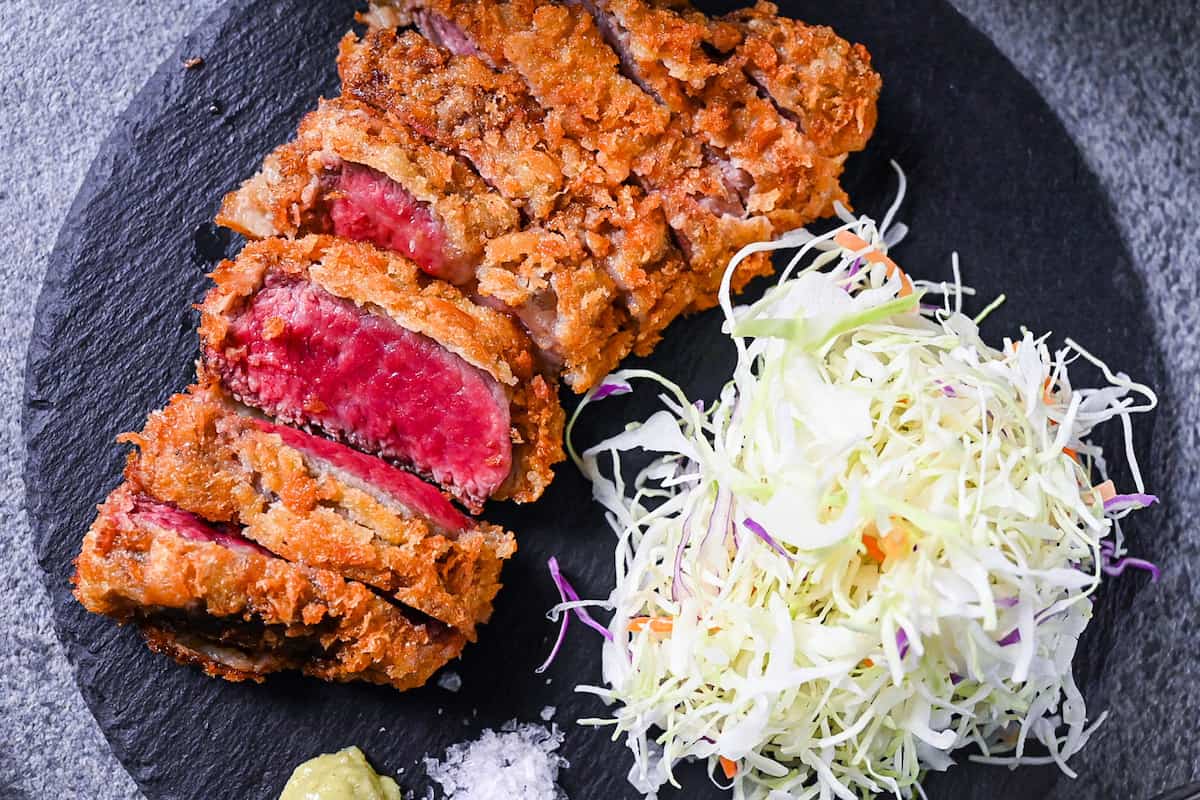
I hope you enjoy this Japanese Beef Steak Cutlet recipe! If you try it out, I’d really appreciate it if you could spare a moment to let me know what you thought by giving a review and star rating in the comments below. It’s also helpful to share any adjustments you made to the recipe with our other readers. Thank you!
More Japanese Katsu Recipes
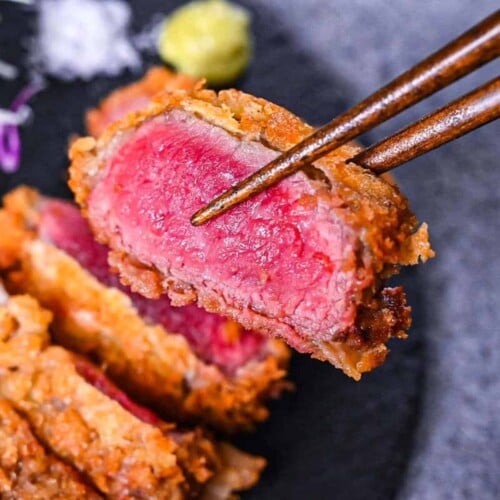
Gyukatsu (Japanese Beef Steak Cutlet)
Equipment
- Japanese-style fryer
- Stainless steel cooking tray with wire rack
- Yukihira saucepan
Ingredients
- 360 g beef steak 2cm thick
- 2 pinches salt
- 2 pinches ground black pepper
- 2 dried bay leaves
- 2 stalks fresh rosemary
- 4 stalks fresh dill
- 200 g onion grated
- 4 tbsp all-purpose flour
- 1 egg
- 1 tbsp milk
- 1 tsp cooking oil
- 100 g panko breadcrumbs
- cooking oil for deep-frying
- salt optional, for dipping
- wasabi paste optional, for dipping
Sauce
- 2 tbsp Japanese soy sauce (koikuchi shoyu)
- 1 tbsp red wine
- 1 tbsp mirin
- 1 tsp ginger paste
- 1 tsp garlic paste
My recommended brands of ingredients and seasonings can be found in my Japanese pantry guide.
Can’t find certain Japanese ingredients? See my substitution guide here.
Instructions
- Stab 360 g beef steak with a clean fork on both sides, dry with kitchen paper and sprinkle each side with a pinch of salt and pepper.

- Place 2 dried bay leaves, 2 stalks fresh rosemary and 4 stalks fresh dill on the top.

- Spread half of the grated onion over the bottom of a container, place the steak on top and then cover the top with the other half. Cover with a lid or plastic wrap and store in a cool place for 30 minutes. (Preferably, not a refrigerator as this slows down the tenderisation process.)

- Mix 2 tbsp Japanese soy sauce (koikuchi shoyu), 1 tbsp mirin, 1 tbsp red wine, 1 tsp ginger paste and 1 tsp garlic paste in a small saucepan. Place on a medium heat and bring to a boil, allow to bubble for 1 minute and then remove from the heat. Set aside for later.

- Once 30 minutes have passed, start heating your oil to 180 °C (356 °F). While you wait, scrape the grated onion and herbs off of the steak. Wash the surface with cold running water and then pat dry with a paper towel.

- Coat the steak with a thin layer of 4 tbsp all-purpose flour all over.

- Whisk 1 egg with 1 tbsp milk and 1 tsp cooking oil until smooth, then coat the steak.

- Finally, coat the steak with a generous layer of 100 g panko breadcrumbs. Gently press them down with your palm to secure them.

- Once the oil is preheated, deep fry steak for 1 minute and a half, turning it over halfway through. In other words, 45 seconds on each side. (For medium rare, you can increase this to one minute on each side, 2 minutes in total.)

- Transfer to a wire rack and allow to rest for 3 minutes. Cut into strips, approx 1.5cm thick (1/2 inch).

- Serve with dipping sauce (or wasabi/salt) and enjoy!

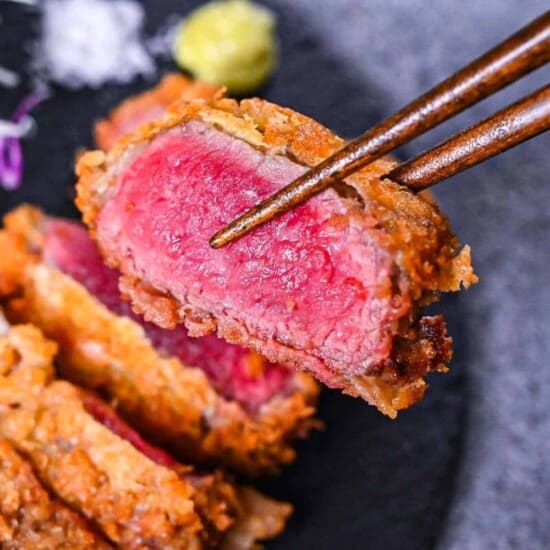


Leave a rating and a comment